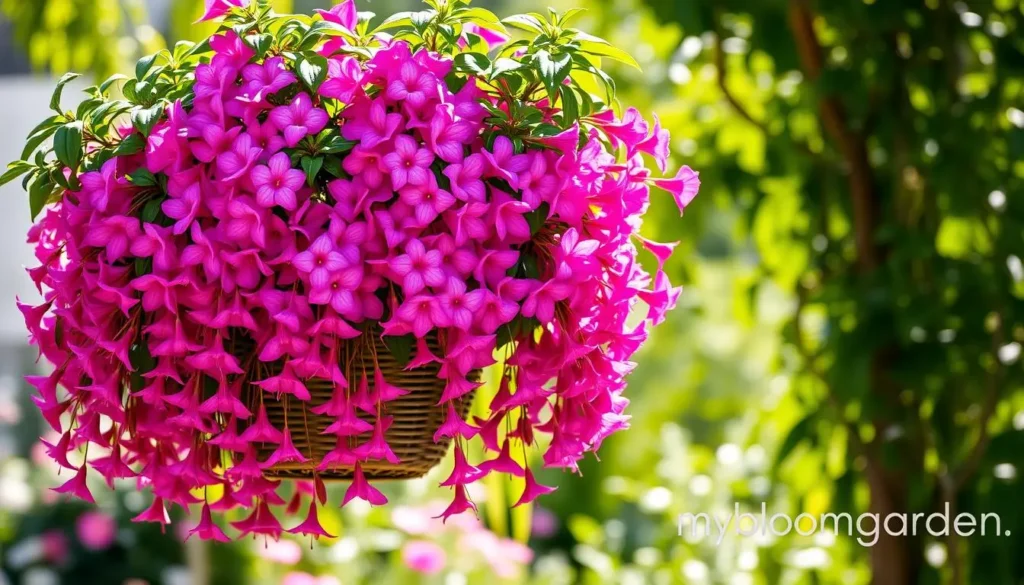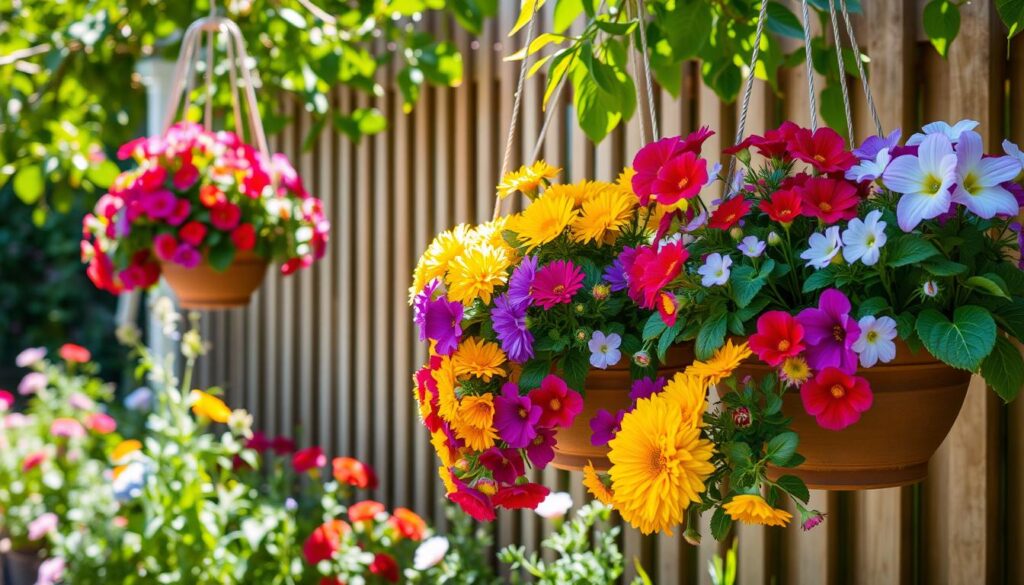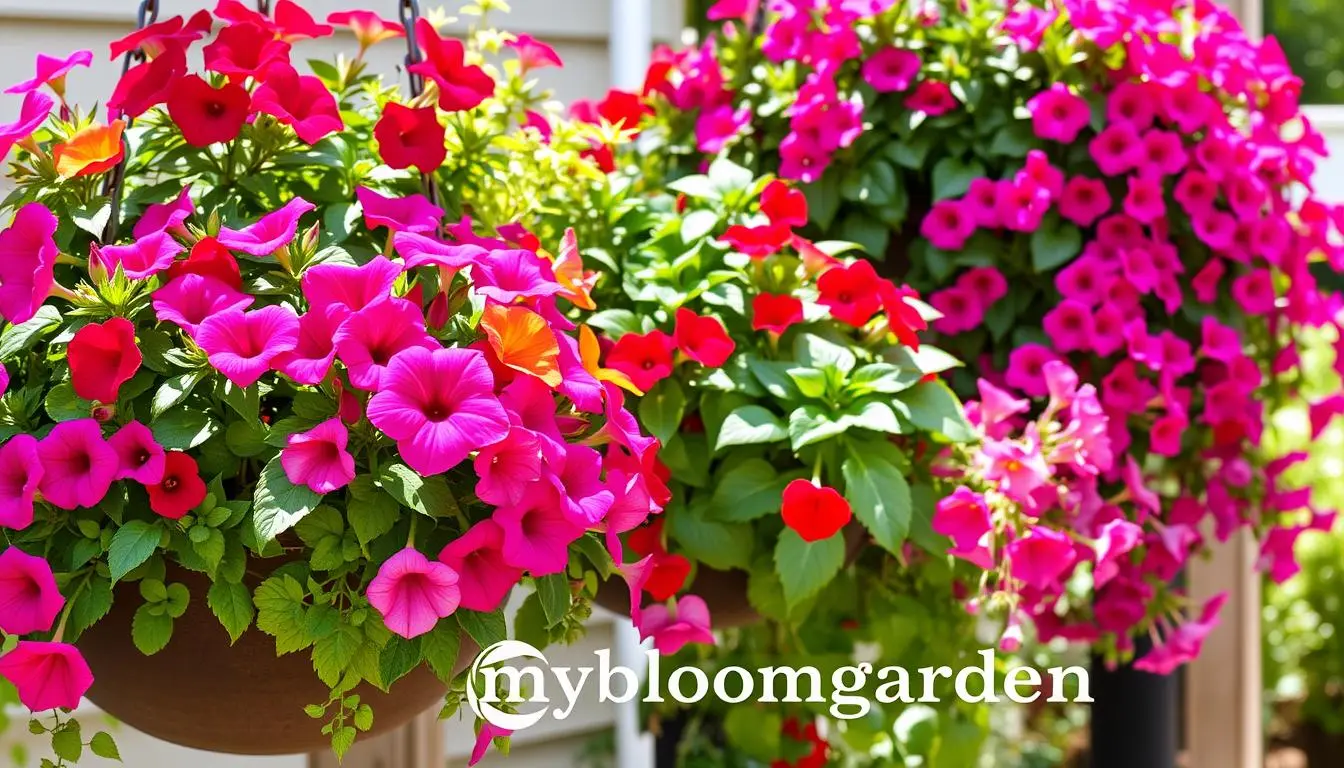As spring sunshine warms your garden, you can’t wait to fill hanging baskets with vibrant flowers. It’s a chance to turn your outdoor space into a colorful paradise. This guide will help you pick the best flowers for your hanging baskets in 2024.
Table of Contents
Understanding Hanging Basket Basics and Requirements
To grow vibrant hanging baskets, you need to know the basics. This includes picking the optimal soil conditions, ensuring drainage solutions, and choosing the ideal basket size. Learning these key points is essential for a beautiful garden practice and showcasing basket garden plants in your container gardening flowers.
Optimal Soil Conditions for Hanging Baskets
The right soil is vital for your hanging baskets. Look for a mix that drains well and is rich in nutrients. Adding compost or peat moss can help with water retention and soil structure.
Proper Drainage Solutions
- Make sure your baskets have enough holes for water to drain.
- Use gravel or broken pottery at the bottom to help with drainage.
- Check the soil moisture often and adjust watering as needed.
Ideal Basket Size Selection
- Pick a basket size that fits your plants’ mature size.
- Bigger baskets, 12 to 16 inches, hold more plants and give them room to grow.
- Smaller baskets, 8 to 10 inches, are great for plants that trail or are compact.
By following these basic steps, you can create a great spot for your hanging basket plants. They will thrive and make your garden practice look amazing all season.
Best Flowers for Hanging Baskets: Top Picks for 2024
Choosing the right flowers for your hanging baskets is key to a stunning display. Looking ahead to 2024, several flowers are top picks for hanging basket lovers. These include trailing flowers, cascading blooms, and flowering vines.
The trailing petunia is a favorite for hanging baskets. These vibrant flowers spill over the basket’s sides, creating a colorful display. The calibrachoa, or “million bells,” is also great. It has small, bell-shaped blooms that stand out.
The fuchsia adds elegance to any basket. These delicate flowers come in many colors, adding whimsy. The lobelia is also popular, with its stunning blue cascades that create a striking contrast.
“Hanging baskets offer a unique opportunity to showcase the beauty of trailing flowers, cascading blooms, and flowering vines. These eye-catching plants can transform even the smallest of spaces into verdant oases.”
When planning your 2024 hanging basket designs, think about the versatility and beauty of these flowers. Whether you want a lush, trailing display or a vibrant, cascading arrangement, these flowers will impress.
Trailing Petunias: The Perfect Cascading Choice
Petunias are a top pick for hanging baskets. They add a beautiful, cascading touch to your displays. Let’s look at the best petunias, colors, and care tips for your baskets.
Wave Petunia Varieties
The Wave petunia series is a favorite for hanging baskets. They come in colors like Purple Wave and Tidal Wave. These petunias grow long and spill over the basket’s edges, creating a stunning look.
Color Combinations and Arrangements
- Pair Wave petunias in colors like pink and white or purple and blue for a nice look.
- Try mixing different petunias for interesting contrasts, like combining trailing with upright types.
- Add other flowers like calibrachoa or lobelia for a layered effect.
Care Requirements for Petunias
To keep petunias happy, they need lots of sunlight and well-draining soil. Water them often, but don’t let the soil get too wet. Use a balanced fertilizer every two weeks to help them bloom. Remove dead flowers to keep them flowering all season.
“Trailing petunias are the true stars of any hanging basket display, cascading with a vibrant array of colors and creating a captivating, eye-catching focal point.”
Vibrant Calibrachoa (Million Bells) for Continuous Blooms
If you want hanging basket flowers that bloom all the time, try Calibrachoa, also known as Million Bells. These annuals do great in hanging baskets, containers, and beds. They add lots of colors and patterns to your colorful hanging basket displays.
Calibrachoa plants are like tiny petunias. They bloom a lot from the start until the first frost. You can pick from many colors, from solid to bicolor and tricolor. Their growth is trailing, making them perfect for hanging baskets.
- Continuous blooms from spring to frost
- Trailing, cascading growth habit
- Diverse color options, including bicolors and tricolors
- Low-maintenance care requirements
To keep Calibrachoa plants happy, give them full sun and well-draining soil. Also, fertilize them regularly. They don’t need deadheading, but a little pruning helps them bloom more. These flowers are essential for any colorful hanging basket displays because they’re easy to care for and bloom a lot.
“Calibrachoa plants are a gardener’s dream, offering non-stop color and a cascading habit that’s perfect for hanging baskets.”
Lobelia: Creating Stunning Blue Cascades
Looking to brighten up your hanging baskets? Lobelia is a great choice. These small, trailing flowers are famous for their blue blooms. They add a beautiful touch to both indoor and outdoor spaces.
Different Lobelia Varieties
Lobelia has many varieties, each with its own charm. The Lobelia erinus has small, bright flowers. The Lobelia x speciosa has larger blooms. You can choose from deep blue to vibrant purple and pink, matching your style.
Growing and Maintenance Tips
- Lobelia loves well-drained, moist soil and partial shade to full sun.
- Deadheading and pruning help it bloom more and look neat.
- Water it well, especially when it’s hot and dry, to keep it looking great.
Companion Planting Options
Lobelia pairs well with plants like Bacopa, Calibrachoa, and Trailing Petunias. Together, they create a stunning display. Lobelia’s blue also complements warmer flowers, adding contrast to your outdoor decor.
“Lobelia’s cascading blue blooms are a true delight, transforming any hanging basket or planter into a captivating focal point.”
Fuschia: Elegant Hanging Basket Showstoppers
Elevate your patio or balcony with fuchsias! These flowers are stunners, with iconic blooms that cascade beautifully. They add elegant whimsy to any outdoor space, making them a top choice for gardeners.
Fuchsias have a unique charm with delicate, bell-shaped blossoms and trailing foliage. They come in vibrant colors like rich purples, fiery reds, and soft pinks. This variety offers endless possibilities for customizing your floral compositions.
Varieties to Explore
- Trailing Fuchsias: Known for their cascading habit, these varieties are perfect for hanging baskets, creating a captivating waterfall of blooms.
- Upright Fuchsias: With their more compact, bushy growth, upright fuchsias make excellent focal points or centerpieces in hanging basket displays.
- Hybrid Fuchsias: Blending the best traits of both trailing and upright varieties, hybrid fuchsias offer a versatile option for your hanging basket designs.
When choosing fuchsias for your hanging baskets, consider their unique care needs and growing conditions. With proper placement, watering, and pruning, these elegant flowers will bloom beautifully for a long season.
“Fuchsias are the jewels in the crown of hanging basket plants, adding a touch of enchantment to any outdoor oasis.”

Essential Care Tips for Thriving Hanging Baskets
Keeping your hanging baskets lush and vibrant takes some effort. But the joy of seeing them flourish is worth it. With the right care, your baskets will stay vibrant all season.
Watering Schedule and Techniques
Watering your hanging baskets right is key. Keep the soil moist but not too wet. Water them every day, or more often when it’s hot and dry.
Make sure to soak the soil well. Let any extra water drain out of the basket.
Fertilizing Guidelines
Feed your baskets with a balanced fertilizer every two weeks. Choose a formula made for container plants. Always follow the instructions on the fertilizer.
Pruning and Deadheading Methods
- Regularly prune your hanging baskets to maintain their shape and encourage new growth.
- Deadhead spent flowers to promote the formation of fresh blooms and prevent seed production.
- Use clean, sharp scissors or pruning shears to make clean cuts and avoid damaging the plant.
“Proper care and maintenance are the keys to keeping your hanging baskets looking their best all season long.”
Follow these care tips to keep your hanging baskets thriving. They’ll add beauty to your garden all season.
Seasonal Planning for Year-Round Display
To keep your hanging baskets looking great all year, plan ahead. Pick plants and flowers that do well in each season. This way, your baskets will always be a highlight in your outdoor area.
Think about what flowers need to grow and when they bloom. For example, pansies and violas are perfect for early spring. Summer is for warm weather flowers like petunias and calibrachoa. In autumn, add chrysanthemums and ornamental kale for a fall look.
When changing your baskets with the seasons, do it slowly. Add new plants as the old ones fade. This keeps your display looking good and avoids sudden changes.
“Carefully curated seasonal displays can transform your outdoor living space into a true work of art, captivating the senses all year round.”
Plan and pick flowers wisely for your hanging baskets. They’ll be a colorful and changing delight all year. Your garden will be a joy to see, showing off the beauty of each season.
- Choose flowers with different bloom times to maintain continuous color
- Gradually transition baskets between seasons for a seamless display
- Incorporate a variety of textures and heights for visual interest
- Consider the unique growing requirements of each plant species
Common Problems and Solutions in Basket Gardening
Keeping your garden healthy and vibrant is rewarding, especially with hanging baskets. Even experienced gardeners face issues that can harm their baskets. Let’s look at ways to solve these problems and keep your baskets looking great.
Pest Management Strategies
Pests can damage your hanging baskets. They harm leaves, flowers, and plant health. Here are some ways to fight pests:
- Check your baskets often for pests like aphids, spider mites, or whiteflies. Act quickly to get rid of them.
- Try organic pest control, like introducing beneficial insects or using neem oil. It’s safe for your plants.
- Make sure there’s good air flow around your baskets. This helps prevent pests and diseases.
Disease Prevention Tips
Diseases can also harm your hanging baskets. They affect plant health and look. Here’s how to prevent and manage diseases:
- Pick plants that are resistant to diseases for your baskets.
- Water and drain your baskets right to avoid fungal diseases.
- Deadhead and prune your plants often. This removes diseased or damaged leaves and helps them grow well.
Troubleshooting Growth Issues
Even careful gardeners might face growth problems in their baskets. Here’s how to fix these issues:
“Proper soil, enough sunlight, and balanced fertilization are key for your basket plants to grow well.”
If your plants are slow-growing, have discolored leaves, or don’t bloom, check their growing conditions. Make changes as needed to help your baskets thrive.

By watching for problems and fixing them quickly, you can keep your hanging baskets healthy and beautiful. This ensures they look great all season long.
Design Tips for Stunning Hanging Basket Arrangements
Adding colorful hanging basket displays to your outdoor space can brighten it up. Whether it’s your patio or entryway, creating beautiful patio hanging basket plants can change your landscape. Here are some tips to make your hanging baskets stand out.
First, think about color harmony. Choose colors that match your home and surroundings. Try bold contrasts or soft monochromatic schemes for a striking look.
- Use flowers of different sizes, shapes, and textures for depth and interest.
- Add trailing vines and cascading plants for a lush, full look.
- Pair plants with colors like vibrant greens, silvery-gray, or deep burgundy for a cohesive design.
“The true essence of hanging baskets lies in their ability to transform even the most ordinary spaces into extraordinary havens of beauty.”
Choosing the right plants is crucial. Mix thriller, filler, and spiller plants for a balanced look. Use plants like trailing petunias, cascading lobelia, and bold fuchsias for a stunning display.
With these tips, you can make stunning hanging basket arrangements that enhance your outdoor space. Be creative, play with colors and textures, and let your hanging baskets be the highlight of your patio or garden.
Low-Maintenance Options for Busy Gardeners
Keeping a hanging basket garden beautiful doesn’t have to be hard, especially for those with little time. Luckily, there are many easy-to-care-for flowers that need little attention. This lets you enjoy their beauty without much work.
Drought-Tolerant Varieties
Drought-tolerant flowers are great for those who want to spend less time watering. These plants can handle dry spells, so you don’t have to water them as often. Good choices include portulaca, lantana, and verbena.
These flowers love the sun and don’t need much water to grow well.
Self-Cleaning Flowers
Self-cleaning flowers are another great choice for easy care. Plants like begonias and million bells drop their old flowers on their own. This means you don’t have to pick them off, saving you time.
This feature also keeps your flowers looking fresh and colorful all season long.
By choosing drought-tolerant and self-cleaning flowers, you can have a beautiful, vibrant garden with little effort. These options are perfect for busy people or those with tough growing conditions. They make it easy to create a stunning garden space.
“When it comes to low-maintenance basket garden plants, drought-tolerant options are a smart choice.”
Conclusion
The world of hanging baskets is full of color and life. You can choose from many best flowers for hanging baskets. Options like trailing petunias, calibrachoa, and fuchsias make any outdoor space beautiful.
Choosing the right plants and taking good care of them is key. Knowing what each flower needs helps your baskets look great all season. With the right care, your baskets will be a colorful highlight.
Don’t be afraid to try new things with your hanging baskets. Find flowers that match your style. With a bit of creativity, your baskets can show off your personal touch.

